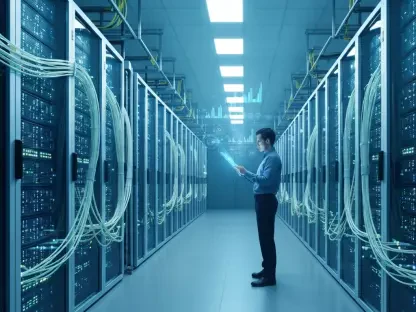The imperative to reduce carbon emissions has become central to manufacturing design and production. This shift is driven by stringent environmental regulations and the need to lower operational costs. Emerging computer-aided design (CAD) tools make it possible to integrate sustainability considerations during the initial stages of product design. Notably, Autodesk’s Fusion 360 Manufacturing Sustainability Insights (MSI) add-on is transforming how engineers and designers approach sustainability in their workflows.
The Intersection of Climate Change and Manufacturing
The Importance of Reducing Carbon Emissions
Manufacturers face mounting pressure to address the compound effects of high carbon emissions and natural phenomena such as El Niño. Research from institutions like NOAA and the Scripps Institution highlights the urgency for proactive measures to mitigate broader socio-economic impacts. These environmental challenges necessitate that manufacturers embrace sustainability, not just for regulatory compliance but to ensure long-term economic viability.As climate change continues its relentless march, the implications of high carbon emissions on global weather patterns have become impossible to ignore. El Niño, characterized by the periodic warming of sea surface temperatures in the central and eastern Pacific Ocean, exacerbates extreme weather conditions and reduces the capability of ecosystems to absorb carbon dioxide. As such, natural phenomena coupled with anthropogenic factors amplify the environmental degradation process, placing an unprecedented strain on both human and natural systems. Addressing these issues is more than a regulatory requirement; it is a necessity for the operational success and sustainability of manufacturing industries.
Incentives Driving Sustainable Practices
Economic benefits are a significant motivator for adopting sustainable manufacturing practices. By lowering carbon emissions, manufacturers can not only comply with regulations but also reduce operational costs. This dual advantage drives the industry towards integrating sustainability into their core design and production processes, embracing a paradigm shift that aligns profitability with ecological responsibility.The ability to achieve cost savings is perhaps the most compelling reason manufacturers are shifting toward greener practices. Energy-efficient processes, waste reduction, and material reuse lead to significant financial savings, making sustainability a key driver of profitability. Furthermore, manufacturers find themselves in a rapidly evolving regulatory landscape where meeting environmental standards is becoming increasingly complex and expensive. Being at the forefront of sustainable practices allows manufacturers to not only stay ahead of these regulations but also appeal to consumers who are increasingly making purchasing decisions based on the environmental credentials of products.
Leveraging CAD Tools for Sustainable Design
Introduction to Autodesk’s Fusion 360 MSI Add-On
The Fusion 360 Manufacturing Sustainability Insights (MSI) add-on by Autodesk is a significant advancement in the field. Launched in collaboration with Gravity Climate, this tool provides engineers with the ability to calculate carbon emissions resulting from various design choices. This integration enables informed decision-making, focusing on sustainability throughout the product lifecycle, from raw material extraction to final processing.In the quest for more sustainable manufacturing, the development of advanced CAD tools like Autodesk’s Fusion 360 MSI add-on represents a game-changing approach for engineers and designers. The MSI add-on offers professionals a robust platform to assess the carbon footprint of their designs before they ever reach the production floor. By partnering with Gravity Climate, Autodesk has endowed this software with the capability to evaluate key parameters, including embodied carbon, loss factors, and carbon costs associated with transportation and processing. With this tool, engineers can pinpoint precisely where in the design process inefficiencies and environmental impacts occur, allowing for modifications that align both ecological and economic goals.
Key Features and Functionalities of MSI
MSI offers several essential parameters for sustainability assessment. It includes details like the embodied carbon of materials, loss factors, and the carbon costs of transportation and processing. Additionally, it lets users track historical changes in design, allowing for continuous improvement in reducing a product’s carbon footprint. The manufacturing location also plays a critical role, as regions with greener standards impact overall sustainability differently.The importance of MSI’s capabilities cannot be overstated. By documenting and displaying the historical changes in a product’s design, MSI allows engineers to understand the impact of previous modifications on the carbon footprint. This historical data is invaluable for iterative design improvement and helps benchmark sustainability progress over time. Moreover, the add-on’s detailed breakdown of embodied carbon—from raw material extraction through to processing and final manufacturing—enables engineers to make better-informed decisions about material choices and production strategies. They can select materials and suppliers based on their sustainability performance, potentially preferring local suppliers to reduce transportation emissions. By helping users understand how different manufacturing locations contribute to the overall carbon footprint, MSI facilitates more environmentally sound decisions early in the design phase.
Digital Twins: A Paradigm Shift in Design Assessment
The Role of Makersite’s Product Lifecycle Intelligence
Makersite’s Product Lifecycle Intelligence (PLI) software offers a unique approach through digital twins, enabling simulation and comparison of design iterations and material choices. These digital replicas provide a holistic view of environmental impacts, considering the entire lifecycle of a product. PLI integrates with existing CAD and PLM tools to offer detailed insights into supply chain dynamics and lifecycle assessments.Digital twins serve as virtual replicas of physical products, capable of simulating various design and material scenarios. Makersite’s PLI software employs these digital twins to revolutionize sustainability assessments. By enabling detailed simulations, the software allows engineers to evaluate multiple design iterations and assess their environmental impacts before any physical prototype is built. PLI’s integration with existing CAD and PLM tools ensures a seamless workflow, enriching the design process with comprehensive sustainability insights. This approach provides a granular understanding of supply chain dynamics, cost implications, and the lifecycle impacts of every material and process used in product development.
Benefits of Lifecycle Assessments and Supply Chain Analysis
PLI’s capability to assess end-of-life considerations and supply chain risks illustrates the interconnected nature of sustainability, production, and supply chain decisions. By evaluating elements like the energy-intensive production of materials such as cobalt, engineers can make more sustainable choices upfront, influencing the product’s overall environmental footprint.The advantages of conducting lifecycle assessments through tools like PLI extend beyond merely meeting regulatory standards. They provide valuable insights into the end-of-life processes associated with a product, such as recyclability and disposal impacts. For example, by acknowledging the high energy cost and environmental impact of cobalt extraction, manufacturers can explore alternative materials or improve recycling processes to mitigate these effects. Such assessments underline the interconnected nature of sustainability, production, and supply chain decisions, bringing a holistic perspective to the forefront of design innovation. Additionally, supply chain analysis highlights sources of potential risks, enabling proactive measures that contribute to more resilient and sustainable supply chains. Understanding these dynamics ensures that manufacturers can make more informed and responsible choices, ultimately leading to products with lower overall environmental footprints.
Advancing Transparency and Accessibility in Sustainability Tools
Balancing Transparency and Competitive Advantage
The push for more transparent and accessible sustainability evaluation tools must balance protecting proprietary processes with fostering industry-wide progress. While advanced software like MSI and PLI offer actionable data, manufacturers need to continuously shape these tools to ensure a balance between transparency and maintaining a competitive edge.As the demand for sustainability grows, manufacturers are increasingly aware of the need for transparency in environmental impact assessments. However, there is a delicate balance to be struck. While sharing sustainability data enhances industry-wide progress and fosters trust among consumers, it also risks exposing proprietary processes that could erode competitive advantages. The challenge lies in developing evaluation tools like MSI and PLI that provide actionable, detailed insights without compromising sensitive business information. Feedback loops between software developers and manufacturers are critical in refining these tools, ensuring they meet the dual demands of transparency and protecting intellectual property.
Future Trends in Sustainable Manufacturing
The trend towards embracing transparent, data-driven design practices is set to shape the future of sustainable manufacturing. By continuously developing and refining tools like MSI and PLI, the industry is moving towards a more coherent, structured approach to sustainability. This shift not only aligns with regulatory demands but also meets consumer expectations for environmentally responsible products.Looking ahead, the future of sustainable manufacturing is firmly anchored in the continued advancement of data-driven design practices. Tools like MSI and PLI represent just the beginning of what is possible when sustainability is integrated into every stage of product development. The industry is likely to see even greater convergence of CAD tools, artificial intelligence, and big data analytics, providing even deeper insights and more refined assessments of carbon footprints and lifecycle impacts. This evolution will not only help manufacturers comply with increasingly stringent environmental regulations but also address the rising consumer demand for sustainability. Early adopters of these advanced tools will find themselves better positioned to meet both current and future regulatory requirements while offering environmentally responsible products that resonate with socially conscious consumers.
Conclusion and Looking Forward
The urgency to cut carbon emissions has now taken a pivotal role in manufacturing design and production. This change is primarily driven by strict environmental regulations and the necessity to reduce operational expenses. Today, advanced computer-aided design (CAD) tools are making it easier to embed sustainability considerations right from the preliminary phases of product design. A standout example is Autodesk’s Fusion 360 Manufacturing Sustainability Insights (MSI) add-on. This tool is revolutionizing the way engineers and designers take sustainability into account in their workflows. By incorporating sustainability metrics directly into the design process, professionals can make more informed decisions that balance performance with environmental impact. This approach not only meets regulatory requirements but also provides a competitive edge by reducing material waste and energy consumption. Thus, the integration of tools like Autodesk’s MSI is not just a trend but a significant step towards a more sustainable future in manufacturing.









